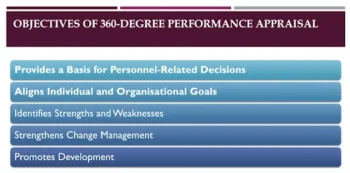Table of Contents:-
- 360 Degree Performance Appraisal Meaning
- What is 360 degree performance appraisal?
- Objectives of 360 Degree Performance Appraisal
- Advantages of 360 Degree Performance Appraisal
360 Degree Performance Appraisal Meaning
360 degree performance appraisal is an orderly aggregation and feedback of performance data about an employee or a group of employees obtained from many stakeholders in their performance. The 360 degree appraisal is also known as multi-source feedback, multi-rater assessment and feedback system, full-circle appraisal, and group performance review. It is a technique to measure the detailed competencies and behaviour of an employee or a group of employees in achieving targets and goals. It is a process in which there are vital stages (after receiving feedback), for improving behavioural patterns.
What is 360 degree performance appraisal?
360 degree performance appraisal is not a speedy process that can be quickly accomplished. The 360-degree performance appraisal has attained popularity because of the changes in the perception the organisations expect from their employees; the increasing necessity of performance measurement, fast-changing management concepts; and better receptive attitude. Participants involved in 360-degree feedback are shown in the figure
Objectives of 360 Degree Performance Appraisal
The 360 degree performance appraisal has the following objectives:
360 degree feedback objectives –
1) Identifies Strengths and Weaknesses
The 360 degree performance appraisal helps identify and evaluate the strengths and weaknesses of an employee against parameters like role performance; performance concerning particular activities; capabilities and working patterns and their suitability for a given task.
2) Strengthens Change Management
The 360-degree feedback complements other efforts in change management, as well as interventional actions towards achieving change effectively, thereby strengthening the change management process. Such efforts may include TQM efforts, customer-focused or customer satisfaction-enhancing efforts, interventions aimed at quality enhancement and cost reduction, and changes required in the decision-making process.
3) Promotes Development
The 360-degree feedback helps in aligning the developmental needs of an employee and consequently blending the development efforts with present and future organisational needs. This helps to objectively plan the development of an employee concerning his current and future roles given the future organisational plans. The development of employees is directed towards developing leadership qualities, team spirit and the desired organisational culture.
4) Provides a Basis for Personnel-Related Decisions
The 360-degree feedback helps to reduce subjective biases and enhance objectivity in deciding rewards, such as performance-linked salary and other personnel decisions (promotion, demotion, transfer, etc.).
5) Aligns Individual and Organisational Goals
The 360-degree feedback can be used to align the aspirations of employees with the goals, vision and values of organisations.

Advantages of 360 Degree Performance Appraisal
The following are the advantages of 360 degree performance appraisal:
1) Provides All-Round Feedback
It gives all-around feedback from various sources like colleagues, supervisors and reporting staff. This helps bring different perspectives into the feedback. The feedback report is formed by combining feedback from various sources to render objectivity to the feedback. Apart from this, it saves the superior time that he would have spent while conducting appraisal alone.
Related Article:- Nature of Marketing
2) Grants Greater Validity and Reliability
360-degree feedback is an in-depth analysis of performance. Thus, it has better reliability and validity. Since there are various raters, on the whole, the feedback has a kind of ambiguity, and it can be considered to be objective. These factors are helpful when the feedback is challenged in court by an employee.
3) Builds Healthy Relationships
Since the feedback is between peers, as well as between superiors and subordinates, it helps to build healthy relationships, All employees are aware that the 360-degree feedback is ultimately meant to improve organisational performance, which becomes a common goal and thus builds up team spirit. As a result, organisational performance and productivity increase.
4) Enables Self-Evaluation
360-degree feedback gives a fair idea to employees about their strengths and weaknesses. If accepted in the right spirit, the feedback serves as an excellent tool for self-evaluation as an individual and as a team. It can encourage the individual employee or the team to take steps to improve upon weaknesses, while the knowledge about strengths improves confidence levels. The strengths and weaknesses of individuals in a team are known by other individuals in that team; this knowledge can be used as an advantage while executing a project.
5) Helps in Planning Career Development
The drawback of the traditional feedback system is that a single person provides feedback. On the other hand, 360-degree feedback is more objective, bias-free, accurate and reliable. An individual employee can trust the feedback and focus on areas that need improvement from the career advancement point of view. This helps plan career development effectively.
6) Facilitates Cost Reduction
Being an in-house process, the cost of this system of feedback is lower as compared to the cost of hiring a consultation organisation or the cost involved in an assessment centre approach.
7) Improves Customer Service
In the 360-degree appraisal process, inputs from internal and external customers are involved. Hence, every employee has access to feedback about the quality of products and services accordingly, he can decide upon ways and means to improve his technique to enhance the quality of products and services.
8) Helps Understand Developmental Needs
The 360-degree feedback throws light on the needs of individual employees, which can be analysed vis-a-vis the organisation’s developmental needs. This provides extensive information regarding the training needs of employees. Also, since 360-degree feedback involves inputs from various individuals, it helps determine training needs, keeping in mind cross-functional responsibilities.
360 degree appraisals are more of a developmental tool than a rating tool, many organizations combine this performance review system with other evaluation tools to accelerate improvement in companies worldwide.
You May Also Like:-
